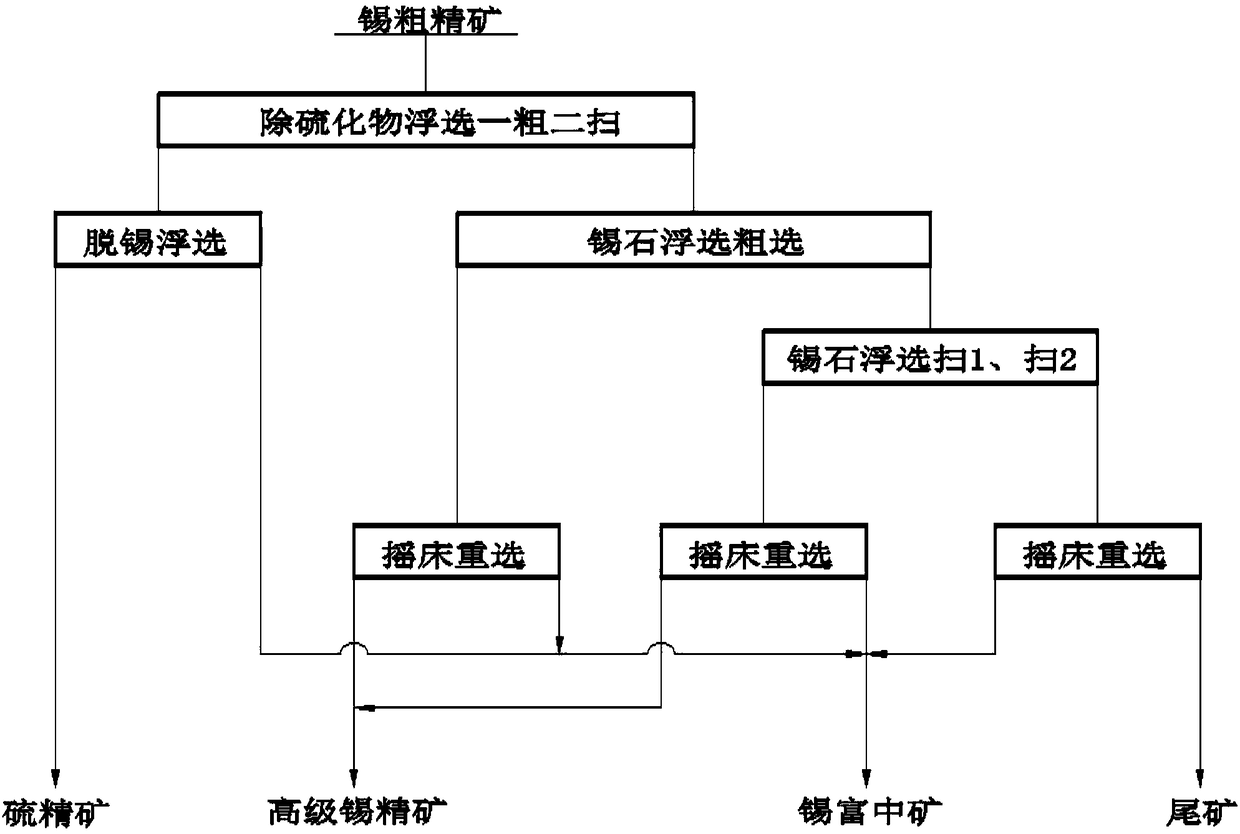A kind of beneficiation and beneficiation process of tin sulfide ore coarse concentrate
A technology for rough concentrate and sulfide ore, applied in chemical instruments and methods, solid separation, wet separation, etc., can solve the problems of high labor intensity, many process links, complex processes, etc., to reduce production costs and classification. Process, the effect of reducing process input
- Summary
- Abstract
- Description
- Claims
- Application Information
AI Technical Summary
Problems solved by technology
Method used
Image
Examples
Embodiment 1
[0022] A beneficiation process for coarse tin sulfide ore concentrate is used to select coarse tin concentrate produced by a 600-ton / day process. The coarse tin concentrate contains 5.871% tin and 10.78% sulfur. Proceed as follows:
[0023] 1) Grinding: all the tin coarse concentrate is mixed into the mill to dissociate the valuable metal minerals separately. At the same time, the grinding process can also make the residual flotation agent in the tin coarse concentrate grind and remove the drug; The concentration of ore is 55-60%, the grading fineness γ-200 mesh content is 70%, and the selected concentration is 30-35%;
[0024] 2) The grinding slurry obtained in step 1) is subjected to rough sulfide separation, two sweep separations, and one beneficiation operation to remove sulfide, and the rough sulfide separation operation adds 80g / t of butyl xanthate and 45g of terpineol oil. / t; add butyl xanthate 60g / t and pinitol oil 30g / t in the first sweep selection; add butyl xanthate 40...
example 2
[0028] The crude tin concentrate produced by the 160 tons / day process is selected. The crude tin concentrate contains 7.685% tin and 8.65% sulfur. Proceed as follows:
[0029] 1) Grinding: all the tin coarse concentrate is mixed into the mill to dissociate the valuable metal minerals separately. At the same time, the grinding process can also make the residual flotation agent in the tin coarse concentrate grind and remove the drug; The concentration of ore is 65%, the grading fineness γ-200 mesh content is 80%, and the selected concentration is 40-45%;
[0030] 2) The grinding slurry obtained in step 1) is subjected to primary sulfide roughing, two sweeping, and one beneficiation operation to remove sulfide, and sulfide roughing operation adds 120g / t butyl xanthate and 80g terpineol oil / t; Add butyl xanthate 40g / t and pinitol oil 40g / t for the first sweep; add 30g / t butyl xanthate and 20g / t pinitol oil for the second sweep, and the order of foaming is returned , Produces sulfide...
Embodiment 3
[0034] A beneficiation process for coarse tin sulfide ore concentrate. The coarse tin concentrate produced by a 200-ton / day process is selected. The crude tin concentrate contains 6.212% tin and 9.65% sulfur. Proceed as follows:
[0035] 1) Grinding: all the tin coarse concentrate is mixed into the mill to dissociate the valuable metal minerals separately, and the residual flotation agent in the tin coarse concentrate is ground and demedicated; the concentration of the slurry is 60%, Grinding classification fineness γ-200 mesh content is 90%, and the selected concentration is 40%;
[0036] 2) The grinding slurry obtained in step 1) is subjected to primary sulfide roughing, two sweeping, and one beneficiation operation to remove sulfide, and sulfide roughing operation adds 60g / t of butyl xanthate and 40g of terpineol oil / t; add butyl xanthate 80g / t and pinitol oil 20g / t for the first sweep; add butyl xanthate 20g / t and pinitol oil 10g / t for the second sweep, and the foam order ret...
PUM
 Login to View More
Login to View More Abstract
Description
Claims
Application Information
 Login to View More
Login to View More - R&D
- Intellectual Property
- Life Sciences
- Materials
- Tech Scout
- Unparalleled Data Quality
- Higher Quality Content
- 60% Fewer Hallucinations
Browse by: Latest US Patents, China's latest patents, Technical Efficacy Thesaurus, Application Domain, Technology Topic, Popular Technical Reports.
© 2025 PatSnap. All rights reserved.Legal|Privacy policy|Modern Slavery Act Transparency Statement|Sitemap|About US| Contact US: help@patsnap.com

